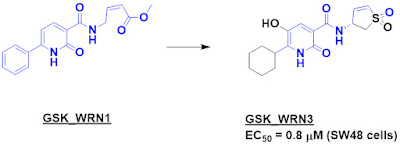Last week Practical Fragments
highlighted a covalent clinical compound from Vividion and Roche against the oncology
target WRN. Another series of inhibitors against this protein are described in
a recent Cancer Discov. paper by Gabriele Picco, Mathew Garnett, and
collaborators at the Wellcome Sanger Institute, GSK, IDEAYA, and several academic
institutes.
As we described in more detail
last week, WRN is a synthetic lethal target for microsatellite instability (MSI)
cancers. In contrast to the Vividion paper, which started by screening covalent
fragments against cell lysates, here the researchers incubated purified WRN protein
against each member of their covalent library (at 20 µM for 24 hours at 21 ºC) and
analyzed the reactions by intact protein mass spectrometry. The fragment library
was based around the methyl acrylate warhead, which, as we discussed a decade
ago, has a narrower range of reactivities than more common acrylamides.
GSK_WRN1 was one of the prominent
hits, with 81% modification. Tryptic digestion revealed that it modified C727,
the same cysteine found by the Vividion researchers. Medicinal chemistry led to
GSK_WRN3, with sub-micromolar activity in MSI SW48 cells. (Unfortunately no
other details on the chemistry are provided; the paper states that these will
be written up separately.)
GSK_WRN3 or a closely related
compound were tested in a battery of assays and found to be inactive against
three other helicases, which is not surprising given that C727 is unique to
WRN. Chemoproteomic studies in cells also revealed the compound to be quite selective
towards WRN vs other proteins. The compounds selectively inhibited MSI cancer
cell lines and patient-derived organoids while sparing microsatellite stable
(MSS) cell lines and organoids. One of the compounds showed activity in a mouse
xenograft model.
In a useful public service, the
researchers tested two previously reported WRN inhibitors, MIRA-1 and NSC617145,
in the same set of several dozen cell lines and found that they were not only
ineffective, they lacked selectivity for MSI cells over MSS cells. Although Dr. Saysno might object, I nominate these molecules to be added to the “Unsuitables”
bestiary at the Chemical Probes Portal.
I do wish more details about the
molecules were provided, especially the kinact/Ki values.
It is interesting that GSK_WRN3 bears remarkable structural similarities
to VVD-109063. IDEAYA recently announced that their collaboration with GSK has
resulted in a development candidate targeting WRN, and it will be fun to see the
full story emerge.




1 comment:
more public service on the artefact WRN tool compounds can be found here: https://doi.org/10.1002/cmdc.202300613
Post a Comment